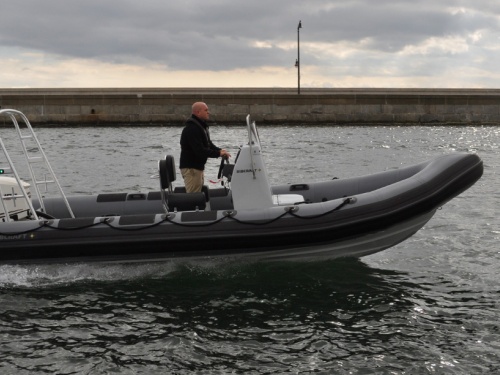Access More Boat Tests
Already have an account? Login
RIBCRAFT 7.8 Offshore (2011-)
Price
See the price by becoming
a BoatTEST member.
Members Must Log In
Brief Summary
If your idea of the perfect land vehicle is a Jeep Wrangler with a soft top and roll cage, you'll love the RIBCRAFT 7.8 Offshore. Depending on her options, the RIBCRAFT 7.8 can become a club launch, tour boat, workboat, megayacht tender, military patrol boat, commando craft for special ops – you name it. We'll take ours with a couple of pod seats behind the helm for security in rough weather, a single four-stroke outboard to keep the price down, and a T-top to carry our radar. Then we'll go out and have fun just messing about in the boat.
Specifications
| Length Overall | 25' 7'' / 7.8 m |
|---|---|
| Beam |
8' 9'' 2.7 m |
| Dry Weight |
2,670 lbs. 1,211 kg |
| Draft |
18'' .46 m w/o engine |
| Deadrise/Transom | 45 deg. |
| Max Headroom | open |
| Bridge Clearance | N/A |
| Fuel Capacity |
100 gal. 378.5 L |
| Water Capacity | N/A |
Engine Options
| Tested Engine |
Currently no test numbers |
|---|---|
| Std. Power |
Not Available |
| Opt. Power |
Not Available |
Warranty
| Hull Warranty Extended | 5 year |
|---|

RIB Advantages
RIBs – rigid inflatable boats – have a thousand uses, from yacht tenders to club launches to lifeboats that can survive in blood-curdling conditions and bring shipwreck victims back alive. Navies and coast guards the world over use them for high-seas vessel interdiction, near-shore patrol missions and special ops they don't tell us about. But RIBs also make good recreational boats, especially for folks who might otherwise buy center consoles or other types of utility boats. They are lightweight – their hull sides are mostly air; the tubes provide lots of stability, so the rigid hull can be narrow and deep for rough-water capability. Their light weight and narrow hulls make them faster than conventional boats for a given horsepower.
Because their hull sides are so light, RIBs are probably the lowest CG of any small boat on the market. The low CG combined with their rounded, buoyant gunwales makes them incredibly stable. Their stability combined with their low freeboard makes them difficult to swamp and capsize.
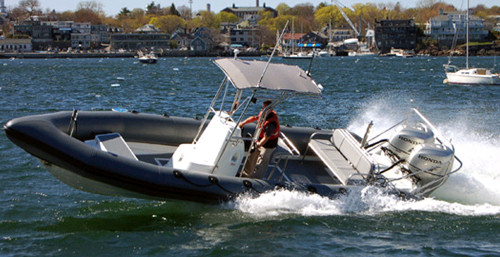
The downside? A RIB will have less usable cockpit area than a conventional hull of similar dimensions because of the tubes. For example, the tubes on the RIBCRAFT 7.8 Offshore are 21" diameter, so its 8'10" beam is effectively a couple of feet less. The narrower beam means the console has to be narrower, too, so there's no chance of fitting a Porta-Potti inside, as is common on conventional 26-foot center consoles. The tubes also do away with under-gunwale stowage, so the RIB owner has to find new homes for boat hooks, paddles, deck brushes and other items typically stowed there. (On the other hand, one need not carry fenders, since they're built into the boat.)
Once again, the Wrangler comparison is apt: No sensible person buys the rugged Jeep because it's a terrific on-road vehicle, and no one will buy the RIBCRAFT 7.8 Offshore because it's a wonderful all-around boat. Both the Jeep and the RIBCRAFT have special abilities that make them attractive to a certain breed of driver/outdoorsman/boater. And there's somewhat of a macho aura around both of them, too.
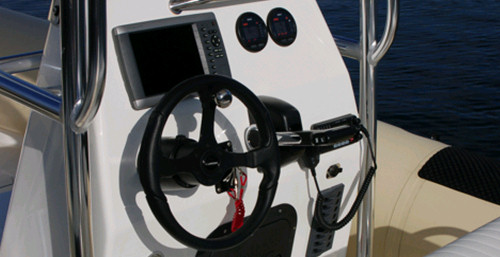
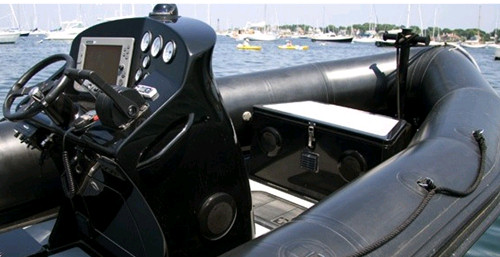
Construction
RIBs are two-part vessels – the rigid part is conventional fiberglass (some RIBs ride on aluminum hulls), while the inflatable part is built of fabric and air. In the RIBCRAFT's case, both parts are built tough enough for commercial, military or lifesaving work. The "recreational" Offshore model differs from, say, the law-enforcement model only in its options. Both boats are built just the same.
RIBCRAFT builds both the rigid and inflatable components in its own factories. The hull is solid fiberglass supported by composite stringers; there is no wood anywhere in the boat. An internal hull liner and a deck mold complete the rigid package; the liner includes a compartment for the aluminum fuel tank. All the components are bonded together with a methacrylate adhesive.
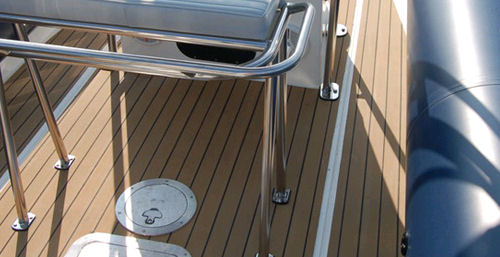
RIBCRAFT tubes are Hypalon on the outside, Neoprene on the inside (two layers of each), reinforced with a polyester mesh in between. Hypalon is the "rubber" used in most quality inflatable boats today – it has high strength and is very UV-resistant. It's not uncommon for Hypalon inflatables to last up to 30 years, even under tropical sun.
The tube on the 7.8 Offshore is one continuous unit comprised of seven air chambers, each one protected by a pressure relief valve to reduce the chance of puncture in the event of collision or other misadventure. The relief valves can also trip on hot afternoons if the tube has been topped-up on a cool morning. Pressure in a properly inflated tube is about 2.7 psi; it's adjusted by feel, not by gauge – pump it up until it's hard, "like a soccer ball," said a company representative.
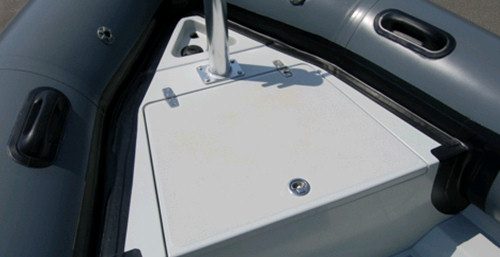
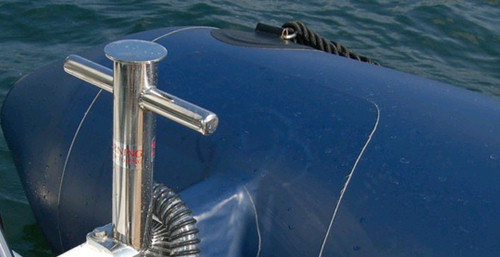
The tube is attached to the hull with adhesive, via a fabric "hinge" glued atop a flange molded into the hull. The hinge lets the tube flex as the boat runs through a chop. The tube is also connected to the bottom of the flange and at the transom, with 20 further reinforcement patches around the hull. There are no mechanical fastenings.
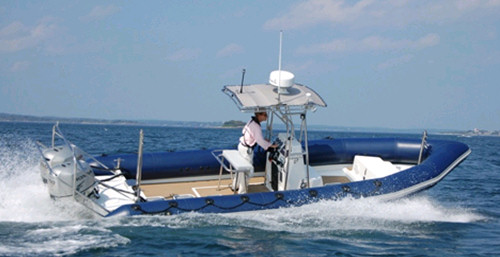
Propulsion
The basic engine package is single or twin outboards up to 350 total horsepower, but since each boat is custom-built, stern- or jet-drives are also possible. We'd choose a single large four-stroke outboard to keep the purchase price down; other users might prefer twins. All brands are available.
We haven't tested the RIBCRAFT 7.8 so cannot provide reliable performance information. However, we would expect a top speed in the low-40-MPH range with the single Honda 225. Because so much of the boat is made of air, its weight is lower than a typical almost-26-footer, which means more speed vs. power. Less power and less fuel burn is needed to achieve a given speed than in a conventional deep-V center console boat.
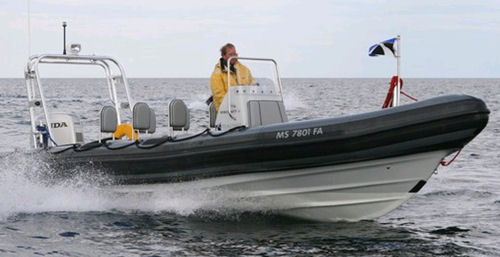
Extras and Pricing
This boat is all about extras: The options you pick can create a military-inspired macho boat for wannabe commandos or a genteel tender for a zillion-dollar megayacht, or anything in between. We spec'ed out a boat for ourselves, taking a conventional recreational path. Base price for the 2011 RIBCRAFT 7.8 Offshore is $61,380; a single Honda 225-hp four-stroke OB, controls and installation adds $20,688 for a boat and motor MSRP of $82,068. The base boat is so well-equipped no options are really necessary.
Nevertheless, we added a T-top ($4,995.75), reinforced bow tubes in case we hit things ($1,825.75), boarding wear patches ($275), tube grab handles $170) and a pair of paddle/boathook retainers ($195). Electronics – Garmin 4208 GPSMAP, VHF and a 12v. outlet – added $4,436.78. Changing tube color from dark to light grey, $699.75. The boat comes with two pod seats at the helm; a bench seat instead is $1,444.05. We'd try the pods. Total price: $98,101.03.
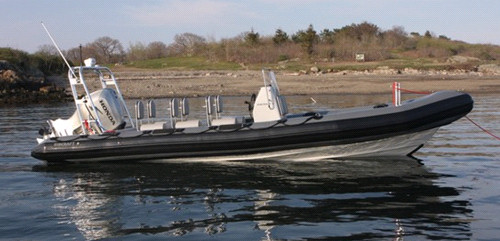
Recommendation
Only you know if you want a RIB, or would do better with a conventional boat. We won't presume to tell you, but if you are a RIB person, the RIBCRAFT 7.8 Offshore is a good choice. It's ruggedly built, can be set up almost any way you want, should be excellent in nasty weather and can carry a load of people or gear. It's just the boat you need for off-road adventures on the water.

